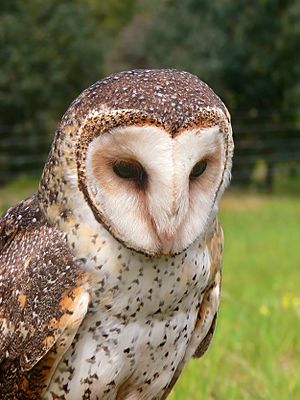Barn owls facts for kids
Quick facts for kids Barn owlsTemporal range: Late Eocene to present
|
|
|---|---|
 |
|
| Australian masked owl (Tyto novaehollandiae) | |
| Scientific classification |
|
| Kingdom: | Animalia |
| Phylum: | Chordata |
| Class: | Aves |
| Order: | Strigiformes |
| Family: | Tytonidae Ridgway, 1914 |
| Genera | |
|
Tyto |
|
| Synonyms | |
|
|
Barn-owls are a special group of owls. They are one of the two main owl families. The other family is called "true owls." Barn-owls are usually medium to large in size. They have big heads and a unique heart-shaped face.
These owls have long, strong legs. Their powerful talons help them catch prey. Barn-owls live in many different places around the world. You won't find them in northern North America or parts of Africa and Asia. They can live in deserts, forests, and even near farms.
Most of the 20 types of barn-owls are not well-known. Some, like the red owl, are rarely seen. But the common barn-owl is famous worldwide. Sadly, five types of barn-owls are currently in danger. Some island species have even become extinct. Barn-owls are mostly active at night. They usually live alone or in pairs and do not migrate.
Contents
Discovering Barn-Owl Types
Barn-owls are split into two main groups. These groups are called subfamilies. One group is the Tyto owls, which includes the common barn owl. The other group is the Phodilinae or bay owls. Scientists believe that modern Tyto and Phodilus owls came from a shared ancestor. This ancestor lived a long time ago, during the Oligocene period.
Scientists found the first clues about these owls in Haiti. They found bones of a very large, now extinct, owl called Tyto ostologa. This discovery led to finding other giant extinct owls nearby.
Living Barn-Owl Groups
Today, we know of two main groups of living barn-owls:
- Genus Tyto – These are the true barn-owls, grass owls, and masked owls. There are 17 known species in this group.
- Genus Phodilus – These are the bay owls. There are 3 known species in this group.
The Tyto Owls
Some well-known Tyto species include the common barn owl (Tyto alba). There's also the American barn owl (Tyto furcata). The Australian barn owl (Tyto delicatula) and the Eastern Barn Owl (T. javanica) are also in this group. Each of these species has many different types, called subspecies.
For example, the common barn owl (T. alba) has 10 subspecies. The American barn owl (T. furcata) has 5 subspecies. The Australian barn owl (T. delicatula) has 4 subspecies.
The common barn owl (T. alba) lives in Africa and parts of Asia. This includes areas in Europe and Asia. The American barn owl (T. furcata) lives across North and South America. The Australian barn owl (T. delicatula) is found in Australia, New Zealand, and some Pacific islands.
The Phodilus Owls
This group includes the Oriental bay owls (P. badius). It also has Congo bay owls (P. prigoginei) and Sri Lanka bay owls (P. assimilis). Bay owls live in much smaller areas than Tyto owls. Oriental bay owls (P. badius) are found in India. Congo bay owls (P. prigoginei) live in Congo. Sri Lanka bay owls (P. assimilis) are found in Sri Lanka.
What Barn-Owls Look Like
The most special thing about a barn-owl is its heart-shaped facial disc. This disc is made of stiff feathers. It helps the owl hear sounds better. It also helps them figure out where sounds are coming from when they hunt. Their wing feathers are also special. They make almost no sound when the owl flies. This helps the owl hear tiny sounds from hidden prey. It also keeps the prey from knowing the owl is coming.
Barn-owls are usually darker on their backs. Their backs are often an orange-brown color. Their fronts are lighter, sometimes a pale version of the back or spotted. But their colors can vary a lot, even within the same species.
Bay owls look a lot like Tyto owls. But they have a facial disc that looks divided. They also have small ear tufts. Bay owls tend to be smaller than Tyto owls.
Images for kids
See also
 In Spanish: Lechuza común para niños
In Spanish: Lechuza común para niños






